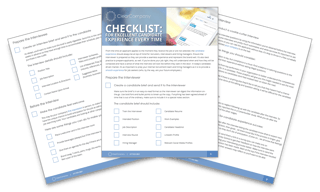The Following article was originally posted in August of 2014 to provide an inside look at talent hiring and forcasting. Since then, it has recently been updated with new stats and information as of Febuary 2017. Need more insight on how to make the best hiring decisions for the future of your company? Check out these related articles:
- Personalize Your Applicant Screening Process for Better Results
- Transforming Your Talent Process: 7 Must Have Downloads
- Top 10 Metrics Driving Quality of Hire
The workforce is changing, and likely so are your talent needs. The Boomers are trickling out, while the Millennials are pouring in, the tech sector is booming, and nearly everyone is having trouble getting their hands on candidates with the right skills. Proactive recruiting tactics are now more important than ever, and here’s why…
More than 60 million Baby Boomers will exit the workforce by 2025, and only 40 million new workers will enter. (Tweet this Stat)
2017 Stat: There are about 80 million Millennials in the U.S. alone, many of which will enter the workforce and account for over 75% of the workforce globally.
It’s doesn’t take a mathematician to figure out the 20 million worker deficit there (and that’s a good thing, because the math field is in serious need of skilled workers). While 2025 might seem too far away to seem relevant, those numbers don’t change overnight. The deficit will happen over the course of a decade, and affect businesses the entire time.
It is projected that 3 out of 4 jobs in the supply chain will change by 2015, and that 60% of all new jobs in the 21st century will require skills that only 20% of the workforce possesses. (Tweet this Stat)
This brings up one of the key factors in successful talent management – training. When the skills simply aren’t there, organizations are going to have to establish working training programs, before it’s too late. If you need the skills today, you should have been creating training programs yesterday.
Employment in professional, scientific and technical services is projected to grow 29% by 2020. This increase will add more than two million new jobs to the US economy. (Tweet this Stat)
The same report revealed that the talent for most of these two million new positions is going to have come from workers outside of the US. The current and projected lack of fundament STEM skills that we’re facing in the US will make internally covering all of those positions impossible.
49% of employers plan to train workers who don’t have experience in their industries and hire them in 2014, that figure is up 10% since 2013. (Tweet this Stat)
Again, we’re seeing a serious need for strong, corporate training programs. When skill gaps and talent needs are projected, the organization is given the necessary time to gather the resources needed to create these training programs.

In 2013, 52% of employers stated that their top business challenge was hiring and retaining talent. (Tweet this Stat)
2017 Stat: One of the top challenges facing 50% of American small businesses during 2016 was hiring new employees.
Do you see this trending business challenge letting up anytime soon? We don’t. Employers have to start investing in building their talent pools, creating dynamic strategies and taking a real look at what they can do to get proactive with their talent needs.
54% of employers currently have open positions for which they can’t find qualified candidates. (Tweet this Stat)
Here we’re identifying that this challenge isn’t just a projection or prediction; it is the current reality. Attracting and recruiting is only going to get tougher, especially without the necessary information to make informed recruiting moves.
While 72% of educational institutions believe recent graduates are ready for work, only 42% of employers agree. (Tweet this Stat)
Do you remember when you left college, and got your first real job and quickly found out how just how unprepared you were? There has always been a disconnect between traditional education and truly applicable skills, but the skill gap and talent shortage has put a magnifying glass on it.
While these stats can come off a little scary to leaders who are already facing talent or skills shortages, this isn’t a scare tactic. This is intended as an eye-opener for those organizations that have not yet invested resources into building strong talent pipelines, worked out a talent strategy, or recognized the effectiveness of talent forecasting. Taking your recruiting to the next level will ensure the talent you need, will always be in supply, and isn’t that what drives and maintains success?
Let’s start a conversation around how your recruiting team can get proactive about your talent needs. Come back to the blog anytime, and we guarantee up to date, fresh talent, goal and performance management content.
.png)

